Harvesting the Moon
by Ricardo Ost Damm Martins, Don van der Lee, and Ruopei Zhang
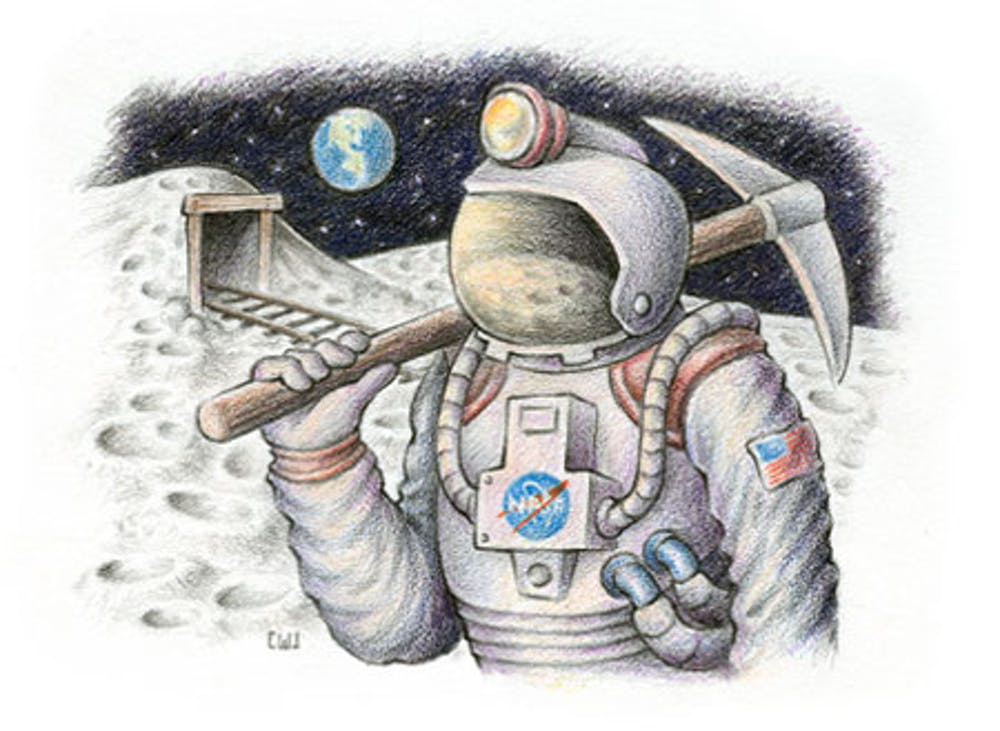
https://theconversation.com/lunar-boom-well-soon-be-mining-the-moon-7031
It is well known that the Earth is a planet with finite space and resources. With a steadily growing population the Earth may soon be at its limit to provide. Due to past and current practices we are at risk of running out of resources that are vital to our way of life. For instance, China produces 90% of rare earth metals that are required for our electronics. Those sources are running out fast and are expected to be depleted.1 It is time to start researching and determining the viability of gathering resources from outside our sphere. This paper will address the question, would it be viable to harvest resources from our Moon in order to mitigate resource constraints on Earth and positively contribute to the global economy?
Throughout this paper the viability of lunar harvesting will be investigated by: what rare and valuable resources the Moon has to offer, the complications and that prevent lunar operations, the technology available and needed to harvest the Moon, and any long-term consequences resulting from lunar mining. The results found are, that helium-3 is a profitable resource to harvest, the polar regions of the Moon contain large quantities of ice for mining purposes, new innovative technologies are continuously being developed to bring the human race to the Moon, and long-term consequences are not likely to occur.
Geology and Structure of the Moon
Since landing on the Moon and discovering raw resources that are available, governments, space agencies and industry, show high interested in mining materials from the lunar surface for purposes ranging from life support, renewable energy, to rocket fuel.
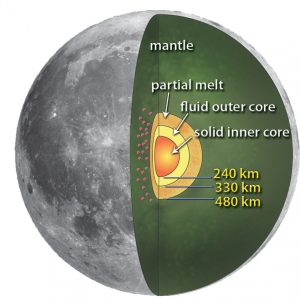
Structure of the Moon
https://www.nasa.gov/centers/marshall/multimedia/photos/2011/photosH-11-004.html
Credit: NASA
The geology and structure of the Moon has a number of features that need to be considered when exploring the idea of harvesting lunar resources. At a high level, it is important to know that all the chemical elements that make up the Moon are also found on Earth but vary in abundance and distribution. It is noteworthy that the Moon has no tectonic plates and no significant atmosphere. Because of these geological features the Moon does not undergo chemical weathering unlike planets found with atmospheres.2 The lack of significant atmosphere and tectonic plates also affect the Moon’s interior and surface with virtually no natural water or other gases.
The Moon is composed of a small core with a radius, mantel, and crust.2 The Moon’s core has a radius of 500 km or less and is believed to be composed of three distinct layers. A solid inner layer composed of solid iron, a liquid iron outer layer, and an outer boundary layer made of partially melted iron and small amounts of light elements like sulfur.3 The mantle and crust contain minerals made of magnesium, oxygen and silicon.4 Research shows that the Moon’s surface was once geologically active and covered in an ocean of magma.4 But today, apart from traces of water ice, the surface is covered in dust and rocky debris.2 The lack of living matter on the Moon causes the soil to lack organic compounds which leaves a more basic set of elements that the Moon is made up of. These elements are primarily oxygen, magnesium, silicon, iron, aluminum, and calcium.4
When considering locations on the Moon to harvest, it is important to note that the near side of the Moon is covered with large dark basaltic plains called maria. Maria are not found on the far side of the Moon which faces away from Earth. On this far side, the crust is thicker with areas up to 76km in depth which will be an important consideration when mining.5 Harvesters will also find topographical features that may influence where mining should take place such as cliffs, mountain ranges, craters and other areas that are the remnants of ancient lava flows and lava tubes.
Lunar Resources
There are several resources that can be found on the Moon and they can all be used in different ways. It will be important to highlight the most valuable resources from the perspective of their price, rarity, and usefulness in determining the viability of lunar harvesting.
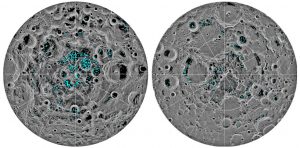
The distribution of surface water-ice at the Moon’s South pole (left) and North pole (right).
https://www.flickr.com/photos/hinkelstone/44133153192
Credit: JAXA/NHK
Water
The first and maybe most important resource is water. Deep craters can be seen and are believed to be thresult of comet and asteroid impacts that distributed water all over the Moon. Most of the water was destroyed by sunlight but it has collected in these dark craters near the Moon’s poles which have floors that never see sunlight. Researchers found tiny patches of ice mixed with rock on the surface of certain craters at the northernmost and southernmost points of the Moon.6 Previous work had hinted that there could be various combinations of hydrogen and oxygen on the Moon, but this was the first to identify actual frozen water molecules on the surface. If ice is at the surface, there could be much more buried below the insulating soil and preserved or diffused into the soil layers.7 The water obtained from the ice can be used as a resource to further mining operations.8
Valuable Resources in the Regolith
The term regolith refers to any layer of material covering solid rock, which can come in the form of dust, soil or broken rock.9 Moon regolith can be used as a building material to create a wide range of structures, roads and infrastructure that could make transportation on the Moon more efficient. This lunar soil can even be used as material for 3D printing if tools or spare parts are needed.1
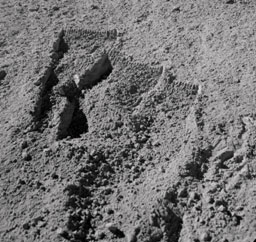
Lunar Regolith
https://isru.nasa.gov/Resources_from_Regolith.html
Credit: NASA
Moon regolith can also be broken down to obtain ultra-pure iron and aluminum which can be used for manufacturing and building other infrastructure which would be required for harvesting operations. This can include the building of shielding material to protect from radiation received both from the Sun and space. This sub-section explores the prominent elements and found in Moon regolith which can be extracted for further use.
Silicon
Starting with the most abundant metalloid on the lunar surface, silicon is the second most common element in the lunar crust after oxygen.10 It is estimated to make up approximately 20% of the Moon’s dirt and can be refined into semi-conductors and used for making solar panels. Silicon is a very useful material; however, it is not a realistic resource to send back to Earth because of its abundance on the planet.
Titanium
Abundant in the maria basalts, the dark spots on the Moon, strong and light titanium forms up to 8 percent of Moon dirt.8 It hangs out mainly in the mineral ilmenite, which also contains iron and oxygen, so refining it might unlock other opportunities. Despite being a very crucial metal for aerospace, titanium is very abundant on Earth.
Aluminum
The lunar highlands are filled with aluminum, another lightweight and sturdy material used in buildings, aircraft, and medical devices.8 The metal makes up about 10 to 18 percent of regolith in these pale spots.8 Iron, titanium, aluminum, and magnesium found on the Moon can all be used for construction purposes and the making of parts. Along with titanium, aluminium is not at risk of depletion on the Earth anytime soon.
Helium-3
Helium-3 is a rare particle on Earth but abundant on the Moons lunar surface and has an energy value in today’s dollars of $5.7 million per kilogram when compared to the value and energy potential of oil.11 It is possible that helium-3 and other solar-wind-implanted-ions, like hydrogen, may be in higher abundance in cold regolith near the lunar poles.12 The cash value of helium-3 would make the overall cost of harvesting on the Moon viable and helium-3 would be valuable to anyone using or worried about using nuclear energy in its current form. Helium-3 has unique properties that provide nuclear energy in a safe manner because it is not radioactive nor would it produce the same kind of radioactive waste that modern nuclear energy does. Dr. Larry Taylor, director of UT’s Planetary Geosciences Institute in Knoxville and geochemist who was involved in the research activities conducted by astronauts in Apollo 17 wrote, “There is more than 100 times more energy in the helium-3 on the Moon than in all the economically recoverable coal, oil, and natural gas on Earth."11
Rare Earth Elements
Fresh deposits of rare-earth elements are scarce on Earth. Rare-earth metals are categorized as 17 highly conductive metals used in every day tech like hybrid car batteries and phones.8 These resources would be extremely valuable and potentially profitable if harvested. Unfortunately, we don’t have much knowledge of the availability of rare Earth elements. Ian Crawford, a professor of planetary science and astrobiology, says posited that if we fully explored the Moon we would find higher concentrations of materials that are not resolvable by orbital remote sensing.12 The Moon might harbor concentrations of rare earth elements such as uranium and thorium and other useful materials that we’re not aware of today in small, geographically restricted areas.12
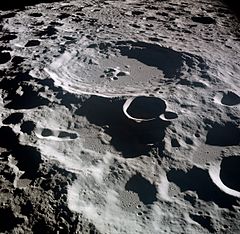
Moon Crater
https://commons.wikimedia.org/wiki/File:Lunar_crater_Daedalus.jpg
Credit: NASA
Platinum Group Metals
Some valuable resources that are found on the lunar surface but may not be indigenous to the Moon are platinum group metals. Platinum group metals or PGMs are a group of elements with similar properties that are considered precious metals.13 These precious metals may be found in crashed asteroid sites. Since the Moon has no significant atmosphere it has been pummeled by asteroids over the eons. At the base of these crash sites might be veins of platinum metals that were deposited by the metallic asteroids.12 The platinum group metals have many uses which accommodate their worth. Some uses for PGMs are found in the automotive, medical, and jewelry industries.13
To summarize the valuable resources available, Dr. Larry Taylor described the Moon as an orbiting space station. Everything astronauts need for planetary travel is already there—hydrogen, oxygen, carbon, and other essentials. The abundance of helium on the Moon represents “the Persian Gulf of energy in the 21st century."10 Helium, with an atomic mass of 3, could have huge importance for generating energy on Earth. At $40,000 to $60,000 per kg for transporting materials from Earth to the Moon, it is not cost effective to go to the Moon even for pure gold (Au), at today's price of $15,500 per kg. He-3 equivalent energy value in today’s dollars is $5.7 Million per kg making this venture for the He-3 fusion reactant worth the effort and cost.10
Harvesting and Transporting Resources
In determining the success of establishing mining operations on the Moon, many factors will have to be reviewed and considered. Scientists have proposed a variety of mining options for the lunar base, including primary mining locations, borrowing from Earth mining technology and mining equipment, computer-controlled remotely operated mining systems, and so on. In this section, the viability of lunar harvesting can be determined as we discuss four phases of lunar mining. The first phase will carry out research in exploration for suitable mining locations. The second phase will build the infrastructure needed for mining, such as transporting parts of the exploration, construction, and mining equipment from the Earth. In the third phase, mining operations will be established and carried out. Finally, the fourth phase will focus on the transportation of materials back to Earth.
Phase 1
In establishing suitable mining locations there are many things to consider and the primary objective would be survivability. Data sent back by the US "Lunar Prospector", which was launched to the sky on January 6, 1998, indicates that there are to 330 million metric tons of water ice at the Moon's poles.14 The Moon is not very inhabitable but because of the large quantity of ice deposits at the polar regions establishing lunar operations is more feasible.
Why would water be of interest to harvesters? Water is heavy and really expensive to transport from Earth. Because it is already on the Moon, it would help make harvesting far less expensive and easier to do. It currently costs $9,100 to $43,180 to send a 16-ounce bottle of water to the International Space Station.15 Currently astronauts drink water that is recycled from their condensation, sweat, and even urine.15 The presence of water will help solve the drinking problem for the mining operators and staff.
In addition to drinking and farming, high temperatures can allow oxygen and hydrogen to be extracted from water. The oxygen extracted could be used for life support and rocket fuel whether that be to come back to Earth or for further space exploration. Oxygen is the most energetic rocket fuel known to humankind and the fact that it can be extracted from the Moon would make further space exploration not only possible but less costly.16 The zero-emission fuel, called hydrogen fuel, is the same used in spacecraft propulsion and fuel cell vehicles. A fueling station on the Moon could ultimately make current space ventures much cheaper and make future space ventures possible. Fueling stations can also be set up in low Earth orbit making it accessible to satellites and other space craft. As of now, satellites that run out of fuel are decommissioned. Extra fuel would allow them to stay in their orbits and increase their life span. Since using rocket to get fuel out of Earth’s atmosphere is expensive, refuelling in low Earth orbit can greatly improve the size, type and cost of missions in space. The commercial launch industry like SpaceX would also benefit from these fuel depots which would increase the viability of harvesting efforts.
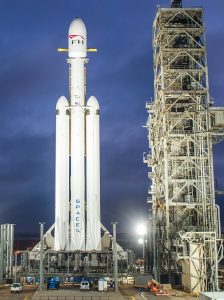
SpaceX's Falcon Heavy rocket
https://commons.wikimedia.org/wiki/File:Falcon-heavy-crop.jpg
Credit: SpaceX
Phase 2
As discussed in phase 1, space travel and shipping are extremely expensive. The outrageous costs of shipping supplies into space, let alone the Moon, are a huge hinderance to the viability of all lunar projects. SpaceX, an aerospace manufacturer is currently working on new rockets and shuttles that will be more efficient in space travel. One such innovative rocket is the Falcon Heavy. The Falcon Heavy is the world’s most powerful rocket able to launch 64 metric tons into orbit.17 Rockets like these can provide a lot of Earth resources that are needed in establishing an initial lunar operation. Once the initial operation is established then lunar resources could be used to expand and cement the project.
The immense amount of silicone found on the Moon could be used in providing a renewable source of energy in the form of solar panels.10 At the polar regions of the Moon sunlight would be provided all year round. This occurs because the spin axis of the Moon is nearly perpendicular to the ecliptic so that the Sun always appears at the horizon of the poles.18 Aside from silicone, titanium and aluminium can also be used in the construction purposes of mining operations.7 Titanium is a known metal used in many aerospace programs and would be of great use. With the ability to use the ample amount of resources that are found on the lunar surface shipping costs could be cut and lunar operations may be more feasible.
Phase 3
In establishing ideal lunar mining operations automated technology will be heavily implemented. Lunar mining will be a highly automated process, usually unattended, and astronauts will inspect and maintain mining equipment from time to time. There are many differences between the mining equipment on the Moon and the mining equipment on the Earth. Most of them are remote-controlled mining robots, which are driven by electricity and can withstand the harsh lunar environment.19 The heavy equipment company, Caterpillar, is currently working with NASA to make use of their breakthrough self-driving, or autonomous, and remote-controlled mining equipment.19 The reality of these automated machines is currently seen in the top 40 mines across the Earth.19
The primary reason for lunar harvesting to be heavily automated is to increase productivity, efficiency, cost controls, and most importantly worker safety. The Moon is a hazard zone for workers. The lunar temperatures are one of the many dangers the lunar staff would need to protect themselves from. When sunlight hits the Moon's surface, the temperature can reach 127 degrees Celsius. When the sun goes down, temperatures can dip to minus 173 Celsius.20 Without the proper precautions the human body would easily burn or freeze at these extremes.
Another danger that the lunar operators face is the intense solar wind storms the Moon experience. Solar wind is a stream of ionized atoms of elements as heavy as iron. If there is a solar flare or coronal mass ejection, the solar wind would be more intense and the Moon would be intensely bombarded by solar wind particles.21 A computer study of the strange effects the solar wind creates as it blows unimpeded across the Moon showed that it could create a condition where hundreds of volts of static electricity in the resource-rich craters could electrocute an astronaut.22 These dangers are still present for the workers that would be required to maintain operations but the automated machinery would reduce some of this risk.
Phase 4
For elements worth transporting back, there is a sequence of complications for returning to Earth. For a specific plan to review and utilize that has worked in the past the 1969 Apollo project may be considered.23 The structure of the Apollo spacecraft was unique and was designed this way with purpose. The shuttle was composed of the spacecraft cabin, the service cabin, the command cabin, and the lunar module. The service and command modules do not enter the Moon's surface but stay in orbit above the Moon on standby. The lunar module will enter the surface of the Earth. When returning to Earth, the upper half of the lunar module will launch fuel to propel the spacecraft up.23 The lower half of the lunar module was abandoned on the surface of the Moon. With the lack of a significant atmosphere on the Moon, the lunar module has almost no air resistance during the ascent process. With the same fuel, the spacecraft will fly faster than leaving the Earth and easily reach the first cosmic velocity of the Moon.23
At this time, in the orbit above the Moon, the control module and the service module are already waiting for each other, and the lunar module will dock with the service module and the command module again. After waiting for the astronauts to enter the service module from the lunar module, they will abandon the lunar module, leaving only the command module and the service module to continue to return to Earth orbit. At this time, the power is provided by the service module. After reaching Earth's orbit, the service module completed its mission, after which the service module will be discarded and returned to the surface of the Earth from the command module.23
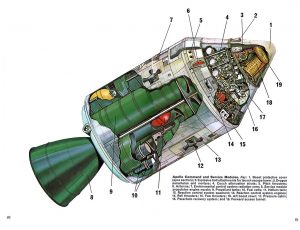
Apollo Command and Service Module
https://www.flickr.com/photos/x-ray_delta_one/5956945078/
At this point the entire lunar landing process is not over. There were four segments of the spacecraft. In the end, only the control capsule carrying the astronaut successfully returned to Earth, and the other parts were abandoned in the universe alone. The space in the control module is very small, and there is only space for two astronauts.23 This particular challenge can be addressed with a reusable spacecraft, which must be able to withstand the tremendous heat and pressure of sufficient control to re-enter the Earth's atmosphere, but must also be able to safely land in a specific location while carrying very heavy cargo.24,1
Currently the technology is not realistically available to carry out large-scale mining on the Moon for returning to Earth. Elon Musk, CEO of SpaceX stated that if we could figure out how to effectively reuse rockets just like airplanes, the cost of access to space would be reduced by as much as a factor of a hundred. A fully reusable vehicle has never been done before and would be a fundamental breakthrough needed to revolutionise access to space.1 When that technology becomes available sending lunar resources such as helium-3 would be quite profitable. As previously discussed, helium-3 has a price tag of 5.7 million dollars per kg and a current launch from SpaceX charges 62 million dollars for payloads weighing up to 50,000 pounds or 22,679 kg.24 A fully loaded shuttle of helium-3 would carry a payload worth 129 billion dollars which would be well worth the 62 million dollar price to launch the shuttle.
Detrimental Effects
To determine if lunar excavating is ultimately viable, the long-term effects of resource harvesting must be investigated. There may be some concerns with the mass removal of material from the Moon which may result in detrimental outcomes. Would the orbit of the Moon be affected through resource harvesting? Would there be critical effects on the Earth’s tidal system? By looking at the Moon’s dimensions and into the theories and laws of gravity these concerns can be met.
Lunar Orbit
To find out if there are any orbital consequences from lunar harvesting it is important to know how orbiting bodies work. Orbits occur from a balance between the forward motion or momentum of a body in space and the pull of gravity from a larger body in space. Through the force of inertia an object with a mass goes forward and “wants” to keep moving forward; however, the gravity of a larger body in space pulls it in. There is a continuous tug-of-war between the forces acting on the smaller body which results in a curved trajectory around the center of mass.26 When these forces are balanced, the smaller body is always falling toward the larger body, but because the smaller body is moving sideways fast enough, it never hits the larger one.26
The physicist Galileo Galilei, a pioneer to modern physics, was fundamental to the discovery of the natural laws of gravity and inertia. Galileo was able to deduce a crucial principle of gravity through experiments involving inclined planes and balls of varying mass. Galileo’s deduction was that the rate of fall of an object is not proportionate to its mass.27 These Galilean laws of physics can be applied to orbital bodies which are in a perpetual freefall. If the mass were to change on the smaller orbiting body the orbit would be completely independent of that change and there would be no effect. The consequences on the lunar orbit from the mass removal of lunar material are negligible; however, will the reduction of the Moon’s mass over the long term have detrimental effects on something else?
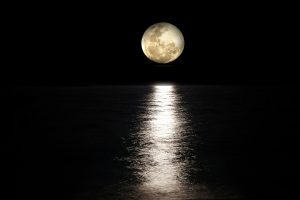
https://pixabay.com/photos/moon-sea-full-moon-2762111/
Credit: Patricia Alexandre from Pixabay
Earth’s Tides
The Earth’s tidal system is a key aspect to essential ecosystems, industries, and weather on the planet.28 Sir Isaac Newton, a renowned physicist from the 17th century, was able to explain the tidal phenomenon with his law of universal gravitation. This law states that any object with a mass attracts any other with a force directly proportional to their masses and inversely proportional to the square of the distance between them.29 This law is explained with the formula![]() which describes the gravitational forces applied between two masses.29 The presence of the Moon’s mass applies a gravitational force upon the Earth which pulls the water in the oceans creating a bulge. This tidal bulge is more of an oval shape, with two simultaneous high tides on each side of the Earth.30 One facing the pull of the Moon and the other on the opposite side of the planet. The Earth’s rapid rotation act on the two tidal bulges in which they continuously undulate around the globe.31
which describes the gravitational forces applied between two masses.29 The presence of the Moon’s mass applies a gravitational force upon the Earth which pulls the water in the oceans creating a bulge. This tidal bulge is more of an oval shape, with two simultaneous high tides on each side of the Earth.30 One facing the pull of the Moon and the other on the opposite side of the planet. The Earth’s rapid rotation act on the two tidal bulges in which they continuously undulate around the globe.31
The tidal system on the Earth is a primary example in which the alteration of the Moon’s mass may cause catastrophic conditions on the Earth. According to the equation of the law of universal gravitation when the mass of one body is greatly decreased the gravitational forces acting on the second body will also be greatly reduced. To fully assess this risk, it would be easier to understand an extreme. What would happen if the Moon’s mass were halved? The acting gravitational force on the Earth would also be halved and the ocean tides would be correspondingly smaller.31
Many implications may occur if the tides were dramatically reduced by half. One such case is the dire dependence that many animals have on the tides for a source of food. The tides also affect other aspects of oceanic life, including the reproductive activities of fish and marine plants.28 These ecosystems that house the lifecycles of many marine life may be at tremendous risk if the tides were to permanently decrease. Another crucial aspect of the tides is how they affect the climate. Tidal currents stir the oceanic waters from the arctic to the tropics. The mixing of arctic and tropic water produces a balance in temperatures which create a more predictable and habitable climate.28 Without the necessary sized tidal currents proper temperature stability may not be feasible.
To determine if the weakening of the Earth’s tides is a serious threat from lunar harvesting then the size of the Moon must be considered. The Moon's mass is 7.35 x 1022 kg, which is about 1.2 percent of Earth's mass.32 Even though the Moon’s mass is a fraction of the Earth’s it is still an incredibly large object. To put that large number into perspective the Earth mined 2.46 x 1012 kg of usable iron ore in 2018.33 Theoretically, if the lunar mines were able to harvest the same amount of iron ore as the Earth every year. In 1 million years the lunar mine would have mined 2.46 x 1018 kg, which is less than 0.01% of the current Moon’s mass.34 The Moon’s mass is so large that lunar harvesting would relatively never reduce the mass of the Moon enough to detrimentally change the acting gravitational force applied to the Earth.
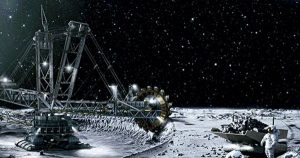
https://trendingposts.net/trending-news/the-european-space-agency-plans-to-start-mining-on-the-moon-by-the-year-2025/
Credit: condecdn.net
Moon’s Appearance
One last concern that would affect the viability of lunar mining is the potential alterations to the Moon’s appearance. The Moon’s surface is composed of familiar outlines of light and dark regions. The dark regions are called Maria which are vast plains of basalt mare deposited by erupting magma.35 The light areas are called the lunar highlands which are composed of the Moon’s crust.35 These beautiful light and dark regions not only provide an impressive aesthetic but also a sense of familiarity. With the appearance of mining facilities across the face of the Moon would the lunar surface be scarred as a result of their harvesting?
To understand the potential disfigurement of the lunar surface it is important to know the Moon’s dimensional size. The total surface area of the Moon is 37.9 million square kilometers. In comparison to the Earth, the Moon’s surface area wouldn’t completely fill up Asia, which has an area of 44.4 million square kilometers.36 Despite the comparison to the Earth, the Moon is still very large. Large enough that if tracts of dark maria were excavated for Helium-3, a multi-kilometer operation would not be visible from Earth.37 In fact the most notable effect to be observed would be the slight brightening of the surface materials.37
Due to the size of the Moon it is highly unlikely that human activities would have any sort of visible change to the Moon’s appearance. Most of the mining facilities would be at the poles where all of the ice excavation would occur.37 These permanently dark areas are not even visible from Earth or from orbit. These factors would strictly benefit the viability of potential lunar harvesting.
Conclusion
We are quickly using up the finite resources available on Earth, but would it be viable to harvest the resources on the Moon? It is our finding that it is viable and would be economical to pursue the most valuable resources.
We discovered that two of the most valuable resources available are water and helium-3. Water is very expensive to transport from Earth and not only can it sustain human and plant life for future manned space missions but the hydrogen and oxygen could be separated and reassembled to make fuel. Helium-3 is one of the highly valuable resources that could essentially pay for the cost of harvesting.
We recommend two approaches to ensure viability. The first is to use water as an in-situ resource where you only mine what would be used in space. Water is a critical resource needed in space and knowing it can be converted to valuable rocket fuel would certainly make the investment worthwhile. Bringing resources from space to Earth only makes sense if what is retrieved is extraordinarily valuable (like helium-3) and not available on Earth. Helium-3 coupled with the large quantities of ice that can be mined, new and innovative technologies that are continuously being developed and the fact that long-term consequences are not likely to occur, we believe harvesting the Moon (in a limited capacity) is viable.
References
1 Mining Technology. Mining the Moon.
https://www.mining-technology.com/features/mining-the-moon/
(Accessed 20 February 2020)
2 GeologyIN. Geology of Moon.
http://www.geologyin.com/2014/12/geology-of-moon.html
(Accessed 20 February 2020)
3 NASA. NASA Research Team Reveals Moon Has Earth-Like Core.
https://www.nasa.gov/topics/moonmars/features/lunar_core.html
(Accessed 17 March 2020)
4 Wanttoknowit.com. What is the Moon Made out of.
https://wanttoknowit.com/what-is-the-moon-made-out-of/
(Accessed 18 March 2020)
5 I. Garrick-Bethell, F. Nimmo, and M. A. Wieczorek, Science 330, 949 (2010)
6 K. E. Foley. After Decades of Work, Scientists Found Direct Evidence of Ice on the Moon.
https://qz.com/1363690/scientists-found-the-moon-has-ice-in-the-shadows-of-its-poles/
(Accessed 18 March 2020)
7 S. Li, P. Lucey, R. Milliken, P. Hayne, E. Fisher, J. Williams, D. Hurley, and R. Elphic, PNAS 115, 8907 (2018)
8 R. Boyle. The Elements We Might Mine of the Moon.
https://www.msn.com/en-ae/news/techandscience/the-elements-we-might-mine-on-the-moon/ar-AACqtqX
(Accessed 17 March 2020)
9 M. Williams. What is Lunar Regolith?
https://www.universetoday.com/20360/lunar-regolith/
(Accessed 15 March 2020)
10 Lunarpedia. Silicon.
http://lunarpedia.org/index.php?title=Silicon
(Accessed 16 March)
11 G. Cramer. There’s Helium-3 in Them There Moon Hills!
(Accessed 18 March 2020)
12D. Leonard. Is Moon Mining Economically Feasible?
https://www.space.com/28189-moon-mining-economic-feasibility.html
(Accessed 18 March 2020)
13 A. M. Helmenlstine. List of Platinum Group Metals or PGMs.
https://www.thoughtco.com/list-of-platinum-group-metals-608462
(Accessed 20 March 2020)
14 NASA. Lunar Prospector.
https://www.nasa.gov/centers/ames/missions/archive/lunarprospector.html
(Accessed 18 March 2020)
15 S. Kramer, D. Mosher. Here's How Much Money it Actually Costs to Launch Stuff into Space.
(Accessed 16 March 2020)
16 D. Leonard. Moon Mining Could Actually work, with the Right Approach.
https://www.space.com/moon-mining-space-exploration-report.html
(Accessed 20 February 2020)
17 SpaceX. Falcon Heavy.
https://www.spacex.com/falcon-heavy
(Accessed 18 March 2020)
18 Lunar and Planetary Institute. The Poles of the Moon.
https://www.lpi.usra.edu/science/moonPoles/
(Accessed 28 March 2020)
19 B. Woods. Caterpillar’s autonomous vehicles may be used by NASA to mine the moon and build a lunar base.
(Accessed 15 March 2020)
20 T. Sharp. What is the Temperature on the Moon?
https://www.space.com/18175-moon-temperature.html
(Accessed 19 March 2020)
21 S. Murmson.Does the Moon Have Solar Winds?
https://sciencing.com/moon-solar-wind-storms-3746.html
(Accessed 15 March 2020)
22 Solar System Exploration Research Virtual Institute. Hazards of Solar Wind on Moon.
https://sservi.nasa.gov/articles/hazards-of-solar-wind-on-moon/
(Accessed 15 March 2020)
23 Smithsonian. Apollo to the Moon.
https://airandspace.si.edu/exhibitions/apollo-to-the-moon/online/apollo-11/about-the-spacecraft.cfm
(Accessed 15 March 2020)
24 Forbes. Why Is It So Difficult For A Returning Spacecraft To Re-Enter Our Atmosphere?
(Accessed 16 March 2020)
25 J. Davis. How much does space travel cost?
https://www.nbcnews.com/mach/science/how-much-does-space-travel-cost-ncna919011
(Accessed 17 March 2020)
26 NASA. What is an Orbit.
https://www.nasa.gov/audience/forstudents/5-8/features/nasa-knows/what-is-orbit-58.html
(Accessed 10 March 2020)
27 A. Van Helden. Galileo Galilei.
https://www.britannica.com/biography/Galileo-Galilei
(Accessed 16 March 2020)
28 Sciencing. Importance of the Tides.
https://sciencing.com/importance-tides-7751713.html
(Accessed 14 March 2020)
29 Britannica. Newtons Law of Gravitation.
https://www.britannica.com/science/Newtons-law-of-gravitation
(Accessed 11 March 2020)
30 V. Hocken. The Moon’s Effect on Ocean
https://www.timeanddate.com/astronomy/moon/tides.html
(Accessed 14 March 2020)
31 N. F. Comins. What Would Happen to Earth if the Moon was Only Half as Massive.
https://www.scientificamerican.com/article/half-mass-moon/
(Accessed 17 March 2020)
32 T. Sharp. How Big is the Moon?
https://www.space.com/18135-how-big-is-the-moon.html
(Accessed 16 March 2020)
33 PUBS. Iron Ore.
https://pubs.usgs.gov/periodicals/mcs2020/mcs2020-iron-ore.pdf
(Accessed 14 March 2020)
34 StackExchange. What Effect Will Mining on the Moon Have Long-term.
(Accessed 14 March 2020)
35 NASA Science. Observing the Moon.
https://moon.nasa.gov/observe-the-moon/viewing-guide/what-can-i-see-on-the-moon/
(Accessed 12 March 2020)
36 F. Cain. Area of the Moon.
https://www.universetoday.com/19925/area-of-the-moon/
(Accessed 15 March 2020)
37 P. D. Spudis. Don’t Worry, a Lunar Return Won’t Harm the Moon.
https://www.airspacemag.com/daily-planet/dont-worry-lunar-return-wont-harm-moon-180969554/
(Accessed 16 March 2020)